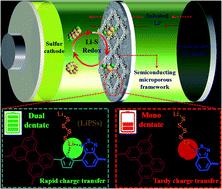当前位置:
X-MOL 学术
›
J. Mater. Chem. A
›
论文详情
Our official English website, www.x-mol.net, welcomes your
feedback! (Note: you will need to create a separate account there.)
Trimming the π bridge of microporous frameworks for bidentate anchoring of polysulfides to stabilize lithium–sulfur batteries
Journal of Materials Chemistry A ( IF 10.7 ) Pub Date : 2020-08-17 , DOI: 10.1039/d0ta06383e Jie Xu 1, 2, 3, 4, 5 , Weiqiang Tang 1, 2, 3, 4, 5 , Fengtao Yu 5, 6, 7, 8, 9 , Shuangliang Zhao 1, 2, 3, 4, 5 , Dongfang Niu 1, 2, 3, 4, 5 , Xinsheng Zhang 1, 2, 3, 4, 5 , Zhong Xin 1, 2, 3, 4, 5 , Renjie Chen 5, 10, 11, 12
Journal of Materials Chemistry A ( IF 10.7 ) Pub Date : 2020-08-17 , DOI: 10.1039/d0ta06383e Jie Xu 1, 2, 3, 4, 5 , Weiqiang Tang 1, 2, 3, 4, 5 , Fengtao Yu 5, 6, 7, 8, 9 , Shuangliang Zhao 1, 2, 3, 4, 5 , Dongfang Niu 1, 2, 3, 4, 5 , Xinsheng Zhang 1, 2, 3, 4, 5 , Zhong Xin 1, 2, 3, 4, 5 , Renjie Chen 5, 10, 11, 12
Affiliation

|
Microporous frameworks with π-conjugated blocks and tunable electronic structures present enormous potential as energy-storage materials. However, the role of the π-bridge and structure–activity relationship have not been explored in lithium–sulfur (Li–S) batteries. Here, we report a π bridge trimming strategy for a semiconducting microporous framework (SMF) with tunable molecular polarity in redox-enhanced and dendrite-free Li–S batteries. The results demonstrate that the π bridge of SMFs plays an important role in polysulfide anchoring and anion immobilization, including the binding energy, charge transfer, redox kinetics, and cyclability, which can be finely regulated by molecular engineering. As a result, SMF-2 with a thiophene bridge achieves bidentate anchoring of lithium polysulfides, which delivers an ultralow capacity-fading rate of 0.033% per cycle for 1000 cycles at 1C and stable Li plating/stripping performance for 300 h. Our work may shed light on the molecular design of π-conjugated materials for advanced Li–S batteries.
中文翻译:

修整微孔框架的π桥,以双齿锚定多硫化物以稳定锂硫电池
具有π共轭嵌段和可调电子结构的微孔框架作为储能材料具有巨大的潜力。但是,在锂硫(Li-S)电池中尚未探讨π桥的作用和结构-活性关系。在这里,我们报告了在氧化还原增强和无枝晶的Li-S电池中具有可调分子极性的半导体微孔框架(SMF)的π桥修整策略。结果表明,SMF的π桥在多硫化物的锚定和阴离子固定中起着重要作用,包括结合能,电荷转移,氧化还原动力学和可循环性,这些都可以通过分子工程进行精细调节。结果,带有噻吩桥的SMF-2实现了多硫化锂的双齿锚固,提供了超低的容量衰减率0。在1C下进行1000次循环,每循环033%,并在300小时内保持稳定的Li镀层/剥离性能。我们的工作可能会为高级Li–S电池的π共轭材料的分子设计提供启发。
更新日期:2020-09-22
中文翻译:

修整微孔框架的π桥,以双齿锚定多硫化物以稳定锂硫电池
具有π共轭嵌段和可调电子结构的微孔框架作为储能材料具有巨大的潜力。但是,在锂硫(Li-S)电池中尚未探讨π桥的作用和结构-活性关系。在这里,我们报告了在氧化还原增强和无枝晶的Li-S电池中具有可调分子极性的半导体微孔框架(SMF)的π桥修整策略。结果表明,SMF的π桥在多硫化物的锚定和阴离子固定中起着重要作用,包括结合能,电荷转移,氧化还原动力学和可循环性,这些都可以通过分子工程进行精细调节。结果,带有噻吩桥的SMF-2实现了多硫化锂的双齿锚固,提供了超低的容量衰减率0。在1C下进行1000次循环,每循环033%,并在300小时内保持稳定的Li镀层/剥离性能。我们的工作可能会为高级Li–S电池的π共轭材料的分子设计提供启发。









































 京公网安备 11010802027423号
京公网安备 11010802027423号